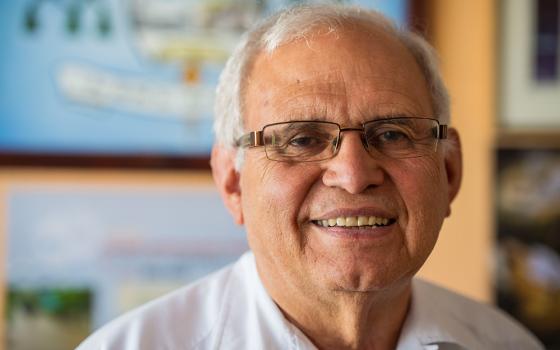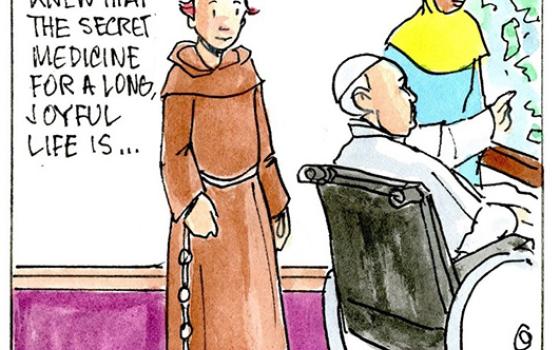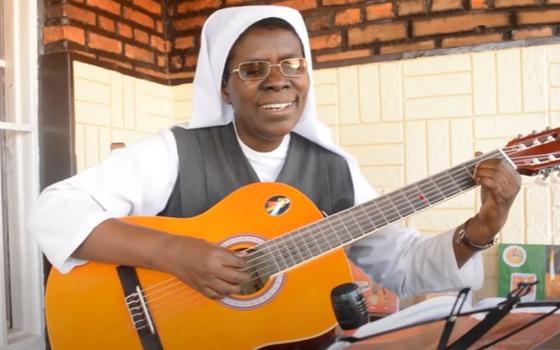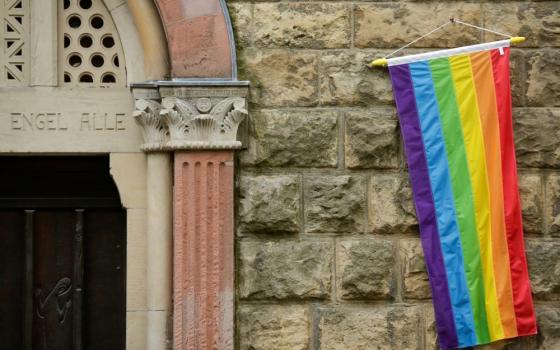COMMENTARY
From all the rich content of Pope Francis’ encyclical “Laudato Si’, on Care for Our Common Home” regarding theological and scriptural understandings of “Our Common Home,” one section has caught the attention of those living in the coalfields of Central Appalachia. In section 165, the pope turns to what needs to be done in light of climate change: “We know that technology based on the use of highly polluting fossil fuels -- especially coal, but also oil and, to a lesser degree, gas -- needs to be progressively replaced without delay.”
The pope understands that this replacement will not occur quickly, but dialogs concerning the world weaning itself from fossil fuels should begin now. The whole tenor of the encyclical supports the inclusion of the working people affected in such dialogs.
The communities of southern West Virginia and eastern Kentucky, hard hit by a half-century of falling employment in the mines, and by the ongoing replacement of coal by natural gas, may well react defensively to the call to decrease use of coal. However, Laudato Si’ is not the first official Catholic teaching document to deal with the environment, the regime of coal in Appalachia, and the inclusion of working families and the poor in discussions of the future of the coalfields.
Two pastoral letters put forth by the bishops of Appalachia in the late 20th century, the bishops of Appalachia addressed the situation in coal-mining areas, and in more recent times, pastoral letters of Bishop Michael J. Bransfield of West Virginia again explored what the church had to say about life in the mountains.
In 1975 appeared “This Land is Home to Me, a pastoral letter on Powerlessness in Appalachia by the Catholic Bishops of the Region.” The letter presents a vision of a church for the poor (without actually using the term) in the context of the challenges of living in the mountain coalfields. Twenty years later, the Appalachian bishops promulgated an anniversary letter, “At Home in the Web of Life, A Pastoral Message on Sustainable Community Appalachia from the Catholic Bishops of the Region.” This letter expanded the message of “This Land is Home to Me” in terms of care of creation -- both of which can be found at www.catholicconferencewv.org – and in a sense, is a “green” version of the earlier letter.
Like “This Land is Home to Me,” the follow-up letter drew upon a series of listening sessions among regular people who live in the mountains. The 1995 testimonies prompted the bishops of the mountains to speak of “God's sacred Appalachia” and the creation in it of sustainable communities “where people and the rest of nature can live together in harmony and not rob future generations.”
The bishops echo Saint John Paul II’s call for us to uphold a culture of life, a culture marked by respect for all persons and by responsible care for creation, rather than one of death, promoting materialism and commodification of everything everywhere. The bishops remind us that “there is only one world, both created and redeemed, and only one God, both Creator and Redeemer.” (Col. 1:15-20)
All too often we forget that redemption by Christ extends to all creation, and, rather than being stewards of nature, we pollute it or use it up. Of course, all too often, we don’t care for our fellow humans, especially the poor and vulnerable. The bishops teach that,
the deep root of the social crisis, that is, the wounding of the poor, and the deep root of the ecological crisis, that is, the wounding of the Earth, can be found in human sin. For what is the oppression of the poor, or still worse their abandonment, but a rejection of the God of love? And what is the destruction of the Earth but another rejection of the same God of love?
We are called to uphold both human ecology (right relations with each other) and natural ecology (right relation to creation). Stating “it is important to stress both natural ecology and social ecology, that is, a sustainable community which embraces humans and all other creatures,” the bishops detail the various ways we can live in a way that makes our communities, economy and technology sustainable into future generations.
While not mentioning mountaintop removal or climate change -- issues of the 21st century -- they provide a series of principles that can guide our discussions regarding such realities. They call for people “to find new ways of living together, based especially on the full community of all life, including love of all nature, and love of the poor.” The letter ends with an echo of the close of the 1975 letter:
Dear sisters and brothers, we urge all of you not to stop living, to be a part of the rebirth of utopias, to recover and defend the struggling dream of Appalachia itself.
Beginning in 2006, Bishop Bransfield of the diocese of Wheeling-Charleston has issued a series of pastoral letters dealing with important issues in the Mountain State: health, children in poverty, the situation of the elderly, mine safety. In all these areas, the bishop calls for creative responses and serious discussion.
These letters (also accessible at www.catholicconferencewv.org) follow the 20th-century Appalachian bishops’ example in drawing upon the testimony of many listening sessions, and also often refer back to the earlier, Appalachia-wide letters. All the letters reflect a principle voiced in the 2006 letter “A Church That Heals,” which “sets a goal of matching the natural and human resources of our state with our moral resources” -- moral resources that include the ability to hold frank discussions of what is needed for the well-being of West Virginians.
While in all his letters Bishop Bransfield comments on the beauty of the landscape in the Mountain State, one letter in particular considers environmental issues. The terrible 2010 Upper Big Branch mine disaster which cost the lives of 29 West Virginia miners sparked “On My Holy Mountain, Mine Safety in West Virginia.” This disaster occurred four years after the Sago Mine Disaster, again in West Virginia, which cost the lives of a dozen miners. This in a century in which such disasters were supposed to never happen in the U.S. In 2010, Bishop Bransfield spoke out strongly:
Experts are clear that such explosions are preventable. We must ask: Is our mining technology in 2010 equal to the technology that is easily available in other industries? Why is it safer to travel in space than to work in a West Virginia mine?
In this letter, he calls for all parties to cooperate in creating more effective safety legislation. Though concentrating on mine safety, “On My Holy Mountain” did take an overview of coal mining in Appalachia, and here it touches on topics Pope Francis considers in Laudato Si’. The letter admits:
This is a time of transition in the coalfields. It is certain that the nation will need our coal for years to come. Just as certainly, our nation’s energy needs must increasingly be met by sources that contribute less carbon to the atmosphere.
Bishop Bransfield speaks of the supply of easily-mined coal dwindling in the future. He writes,
New policies, new techniques, new ideas will be coming to the mountains which have for so long supplied the energy of this country. “There is a saying in the region that coal is king.” The Bishops of Appalachia in their 1975 pastoral letter This Land is Home to Me recognized that “the coal-based industry created many jobs, and brought great progress to our country.” They also frankly acknowledged that “oppression for the mountains” and suffering for many resulted from tragedies like the Upper Big Branch Mine Disaster. And they warned that the temptation toward “maximization of profit” can lead to a disregard for human beings and their needs and lead to “a new kind of powerlessness.”
In his mine-safety letter, the Bishop recognizes that in southern West Virginia, “coal is not simply a way to make a living, it is a way of life.” Change in coalfield ways will not simply be a shift in jobs, but a wrenching transformation of culture amidst the beloved, beautiful mountains. He ends the letter calling for cooperation to end the tragic cycle of mine disasters. He continues,
Let us pray that healthy living, pure water, and clean air will return to the coal mining regions of our beautiful Mountain State. May Our Lady, help of Christians, and St. Joseph the Worker, her Spouse, intercede for us, watch over the families and communities affected by this tragedy, and bring to completion the good work we have begun in Christ our Lord.
In interviews after the publication of Laudato Si’, Bishop Bransfield recognizes that the transition from coal is accelerating in Appalachia and the coal way of life is coming to an end. In this time of coalfields transition, he does not see the serious discussion that should be happening about the coal communities’ future. He told West Virginia Public Broadcasting that he and the West Virginia Council of Churches has interest in dialoging with leaders and innovators in the region to work to “secure the future in the coalfields and for all the people of West Virginia.”
“At Home in the Web of Life” and “On My Holy Mountain” serve as precursors for Laudato Si’, applying the pope’s call for care for creation and the poor, conversion of heart in light of the Common Good, and inclusion of those impacted by environmental changes in discussions of the future of “God’s Sacred Appalachia.”
The pope’s “Prayer in Union with Creation” sums up many themes of pastoral letters from the mountains:
Enlighten those who possess power and money
that they may avoid the sin of indifference,
that they may love the common good, advance the weak,
and care for this world in which we live.
The poor and the earth are crying out.
O Lord, seize us with your power and light,
help us to protect all life,
to prepare for a better future,
for the coming of your Kingdom
of justice, peace, love and beauty.
Praise be to you!
Amen.
[Rev. Brian O’Donnell, S.J., Ph.D., is the Executive Secretary of the Catholic Conference of West Virginia and a member of the Jesuit community at Wheeling Jesuit University.]



